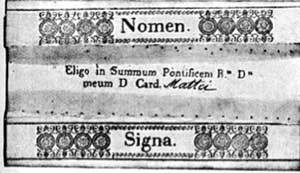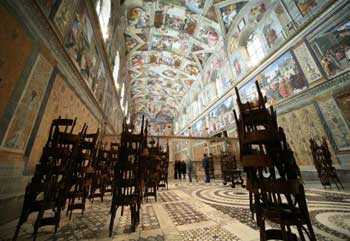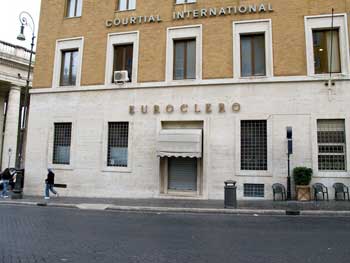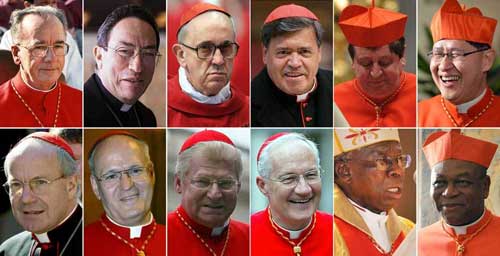
Sorry, but we realy love that one! 🙂


Sorry, but we realy love that one! 🙂
With this Decree (motu proprio), the Pope grants the Cardinals to bring forward the start of the conclave, as soon as all papal electors have arrived in Rome, said Vatican spokesman Father Federico Lombardi. Recently there had been speculations over an earlier meeting of the Conclave, after several cardinals had apparently voted for it.
The bringing forward of the Conclave, to the first half of March, will allow Benedict’s successor to better prepare for the Holy Week starting on March 24, and Easter which is on on March 31. There had been speculations in Rome now for days about a conclave beginning on the 10th or 11th of March. The date of the beginning of the Conclave is expected to be announced by end of Benedict’s pontificate.
Benedict XVI. announced his resignation for the upcoming Thursday – February 28. The rules which had been defined by Benedict’s predecessor John Paul II. in the Apostolic Constitution “Universi Dominici Gregis” in 1996, provided that the conclave has to start between 15 and 20 days after the Holy See has become vacant. The timeframe should allow the Cardinals from around the world to go to Rome. This time however, numerous Cardinals have already gathered in the Vatican to bid farewell to Benedict.
Lombardi had recently declared, the rules for the meeting of the conclave were designed for the case that a pope dies. With the resignation of Benedict XVI., the situation is different, and “it is possible to interpret the rules differently”. It is crucial that all Cardinals are gathered, and with the resignation announcement they had more time to do so.
The 117 Cardinals eligible to vote, which may not be older than 80 years, will hold their Conclave in secret sessions in the Sistine Chapel. According to current knowledge, two eligible Cardinals will not participate in any way in the election – Cardinal Julius Riyadi Darmaatmadja from Indonesia and the retired Scottish Cardinal O’Brien.
According to journalists and Pope biographer Peter Seewald, the “Vatileaks” affair was not the reason for Benedict XVI’s resignation. The betrayal of his long-time servant Paolo Gabriele had neither thrown the Pope off track, nor tired of office, Seewald reported after a conversation with Benedict XVI. at the summer residence in Castel Gandolfo last August. BBut the case of the stolen papal documents that have partly publicly accessible, is one of the most spectacular scandals in the entire history of the Vatican.
So far, there has never been faced a that close collaborator of the Pope with such serious allegations. Therefore it cannot be ruled out, that the bitterness in consequence of the scandal, as well as the factional infighting among the Cardinals in the Curia have encouraged the Pope in his decision to resign. On Thursday the Italian newspaper “La Repubblica” wrote, that some Cardinals might be susceptible to blackmail, referring to a secret report regarding the “Vatileaks” affair, that three Cardinals had presented to the Pope on December 17 2012.
The report of the three-member Cardinal Commission about the scandal continues to be officially kept secret. Therefore it is still not known through which of the many duplicate letters and reports the Pope might have been susceptible to blackmail. Further there are circulating speculations, that the Italian intelligence service had obtained the material.
After the imposition of a mild 18-month prison sentence against Gabriele and his pardon before Christmas, there remain many unanswered questions about possible accomplices and the motives that may have led the 46-year-olds to the systematic theft of confidential documents of the Pope.
“The ballots must be rectangular and must contain if possible in the upper half of the printed form the words: Eligo in Summum Pontificem, while the lower half must remain free to write the name of the selected here.” So it is written in section 65 of the Apostolic Constitution “Universi Dominici Gregis” of Pope John Paul II, the Pope’s election regulations currently in effect for the Conclave.
 Papal voting card
Papal voting card
But not only the nature of the ballot is regulated in detail. The Pope election rules dating back to 1996, which were changed in one point by Benedict XVI in 2007, contain some strict provisions, which go far beyond the election process itself.
The Dean of the College of Cardinals shall preside at the election, unless he is over 80 and thus no longer eligible to vote. In this case, he will be replaced by the Vice-Dean. If he is also over 80, the oldest of the highest ranking Cardinals takes over. This scenario will occur in the current conclave. Dean Angelo Sodano and Subdean Roger Etchegaray are over 80, so the 79-year-old retired Prefect of the Congregation of Bishops Giovanni Battista Re will take over the presidency of the conclave.
During the conclave, the cardinals will reside in the premises of the Domus Sanctae Marthae, the guest house of the Vatican. The rooms are – mandatory by the electoral law – allocated by lottery. In addition to the Cardinals a few more people are involved, who need to swear under oath their ‘obligation to secrecy’. These include, among others, “two doctors for emergencies”, “some religious priests of different languages for confession” and “an appropriate number” of people “for service and cleaning.”
 Sistine chapel
Sistine chapel
The family Gammarelli, that dresses the Cardinals at the Vatican since 1793, and the younger rival Euroclero, who supplied Josef Ratzinger with robes during his 20 years as a Curial Cardinal, and to whom Benedict has remained loyal in his years as Pope.

The tailor shop that receives the order from the Vatican must make three complete Pope robes until the beginning of the conclave – in sizes small, medium and large. Because it is unclear what stature the new Pontiff will have, several vestments must be sewn. As of this writing the story is told in Rome about John XXIII., the “good Pope,”: the full-bodied Italian looked like a “sausage” in his too-tight suit. Before he appeared on the Loggia of St. Peter’s after the “Habemus papam” in 1958, the back seam had to be unstitched. Each Pope robe includes also a hat, cape, sash, cassock, red shoes and a whole lot more.
Therefore Cardinal Lubomyr Husar from the Ukraine, born on Feb 26 1933, is not eligible to vote.

This years Ash Wednesday in Rome is all about the demise of Pope Benedict XVI., who retires at the end of February from the highest office of the Catholic Church. In the evening, after the general Audience, the Pope celebrated his last Ash Wednesday liturgy before numerous church dignitaries and thousands of believers. He was greeted with thunderous applause.
In his sermon Benedict XVI. issued a call for renewal and conversion during Lent the worshipers. This just serves to renew the conversation and concrete actions. “Today, many are ready to tear down their clothes in the face of scandals and injustices – which were of course committed by others – but few seem only willing to work on one’s own heart, one’s own conscience and their own intentions, and thereby leave the conversion, renovation and conversion to the Lord, “said Benedict XVI.

It is important to remember this and to live that this Lent: Everyone should be aware that the path of penance could not be overcome alone, but together with the many brothers and sisters in the Church, the Pope said.
“I think especially of the sin against the unity of the Church, to the divisions in the body of the Church,” the Pope said. “To live Lent in a more intense and visible ecclesial community and overcome the individualism and rivalries, is a humble and precious testimony to those who turned away from faith or are indifferent.”